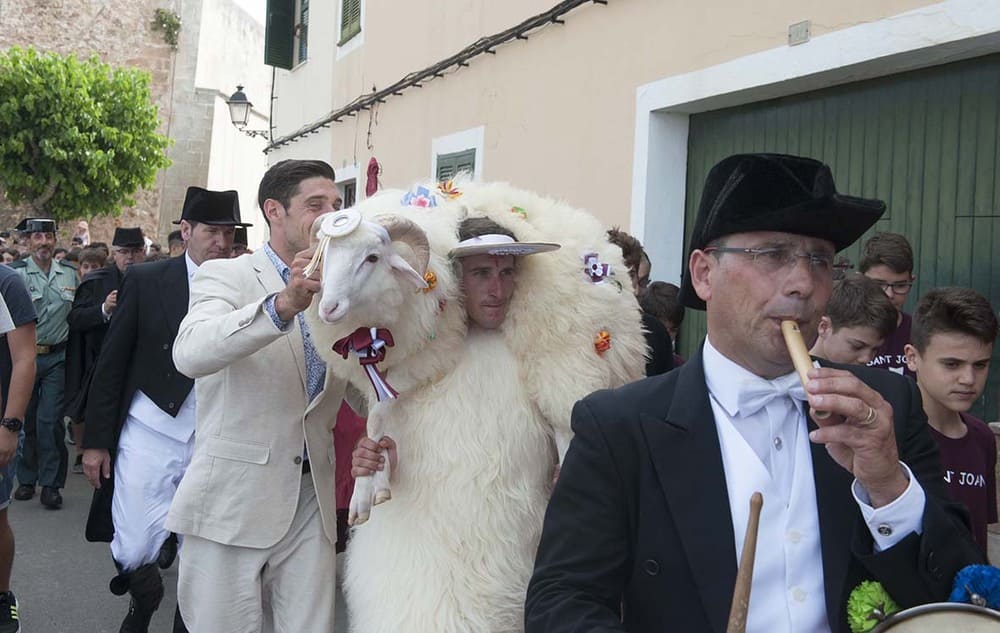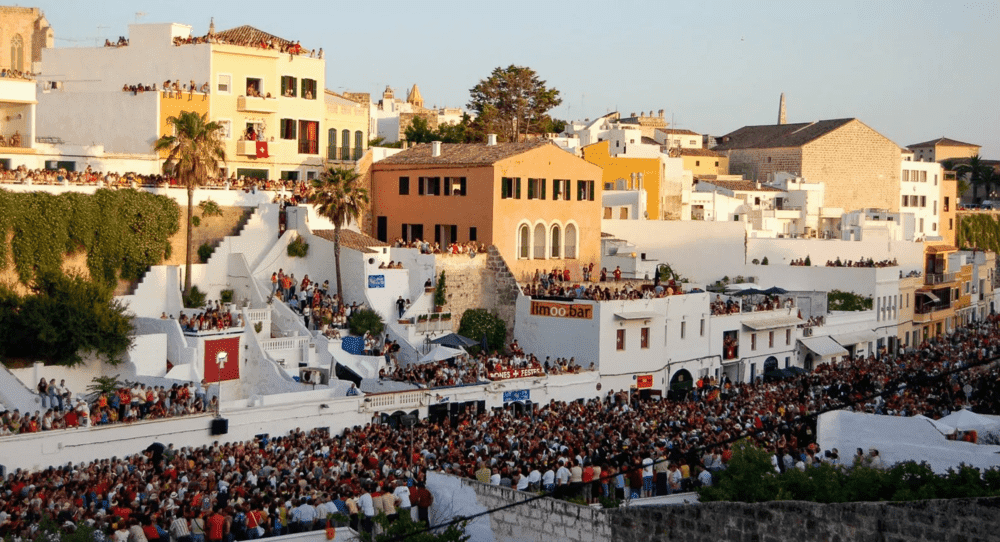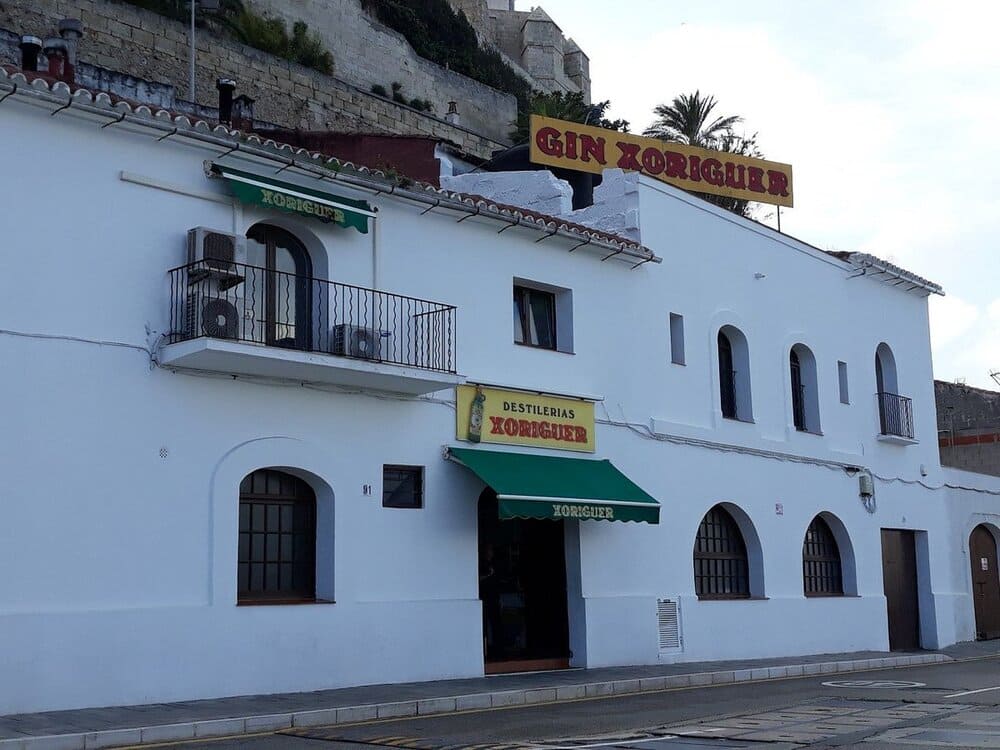This article describes the patronal feasts of Menorca 2023, so that during your stay on the island in the summer at ARTIEM Audax, ARTIEM Capri or ARTIEM Carlos, you can make the most of these unique festivals and experience them as if you were a local.
From June to September, all the towns of Menorca celebrate their patronal feasts, where the Menorquin horse breed is the common element. They are mounted by horsemen dressed in the same costume, who participate in a cavalcade on the main streets of each town.
For two days, social, religious and festive traditions are interlinked with music, people and horses, giving rise to a centenary tradition with deeply sentimental roots.
The two most important are those that open and close the festivals: Sant Joan in Ciutadella and Mare de Déu de Gràcia in Maó, share the same festive spirit, but each one has its own traditions and customs. For this reason, there are two important differences between the Festival of Sant Joan in Ciutadella and those of the rest of Menorca. Whereas the former is based on a series of strict centuries old protocols that define the daily activities of the festival and how each thing must be done, and is organised by the nobility, in the rest of the towns, the protocols are more flexible and the town council is responsible for the organisation.
Sant Joan de Ciutadella – Menorca
The festival of Sant Joan in Ciutadella is held at the beginning of the summer and is the most popular in Menorca, the islands and the peninsula.
The festival has a religious origin and the classes represented are the clergy, the peasants and the noble class. The tradition goes back to the romeria of Sant Joan de Missa, a pilgrimage to the chapel of said Saint attended by penitents and their families and friends. On the way back, they passed through Ciutadella. Over the years, the festival began to include games of skills that existed at the time, different activities and above all, it won the favour of the general public.
As already mentioned, the festival is always governed by strict protocols that indicate what should be done at each time and how to do it, including where to go and how to greet others. They are only known to the inhabitants of Ciutadella who pass them down from generation to generation.
In Ciutadella, the festival starts on the Sunday before St. John’s Day (24th of June), and St. John the Baptist comes to life as s’homo des be, a figure representing the apostle who carries a lamb and passes through the streets inviting all the horsemen to attend the festivities on the 23rd and 24th of June. According to popular tradition, touching es be brings good luck all the year.

https://menorcaaldia.com/2018/06/17/fotos-shomo-des-be-da-inicio-a-sant-joan/
On the 23rd, of June at 2 p.m., the festival begins in Ciutadella, and the festivities start on the first note of the flabiol (a type of flute). It starts with the replec (gathering), and is followed by activities such as caragol d’es born, ses avellanes, caragol de ses voltes, cargol de Santa Clara… There is a long list of social, religious and festive acts that are perfectly interlinked, surrounded by crowds, gin, hot chocolate with coca bamba, (a typical spiral-shaped bun) and music played by the town band.

https://lasiestamagazine.mallorcadiario.com/como-se-viven-en-menorca-las-fiestas-de-sant-joan
On the 24th at first light, after taking down the flag, the rehearsals of the jocs de Pla (mediaeval games) are held, which include córrer abraçats (running hugging) and córrer s’ensortilla (threading the ring) where the horsemen practise for the night event. After the rehearsals, the corregudes, caragols, begudes, missa, sa convidada, etc. continue and then comes one of the highlights of the festival: es jocs des Pla, where games, music and festive events create a fantastic experience that continues with more caragols and missa and ends with the darrer toc de flabiol (the last note of the flute), when the festival ends during the early hours of the 25th.
One peculiarity of the festival is that in Ciutadella, the colcada (cavalcade) is presided by a noble, the caixer senyor, and the main figures are:
- The caixer senyor representing the nobility.
- The caixer capellà representing the church.
- The caixer casat representing the artisans. They must be married and be master of a craft trade.
- The caixer fadrí must be an apprentice peasant or artisan (it changes every two years) and must be single. If they are an artisan, they must wear white trousers and if they are a peasant, black ones.
- The caixers pagesos who represent the peasants.
- The flabioler (flute player), who always rides a donkey and plays the drum and the flabiol to announce the arrival of the horsemen.
The order of the cavalcade is: first the flabioler, followed by the caixer fadrí, the married man, and then the rest of the horsemen, firstly the local peasants and then others, and at the end, the committee, formed by the caixer senyor and lastly sa capellana (or caixer capellà).
In the other towns of the island, each has their own peculiarities and traditions, but they also celebrate the patronal feasts with the horse as the main element.
All the men and women of the town can take part in them, dressed in the same costume: a black frock coat, white trousers, white shirt, a tie, a hat and black riding boots. The flabioler figure is also a common element in all of them, with the difference being their song, which is unique for every town. The committee, to the sound of the song and always with the horsemen ordered from youngest to oldest and ending with a person representing the church and another representing the town council, preside the festivities. It always passes through the town and invites all citizens to take part in the festival in the square of each town hall, where the horsemen show off their skills on horseback to the sound of music played by the town band.
One common characteristic in all the festivals, also in Sant Joan festivals, is the traditional drink called pomada or gin and lemonade, depending on the side of the island. The drink is made of gin (Gin Xoriguer) which is made on the island (you can visit the factory during your stay in Menorca), and natural lemonade. Without a doubt the pomada is the perfect accompaniment to the activities.

Now that you know their history and peculiarities, we offer you some practical information about how to enjoy them in full:
- How to get there: like all towns with festivals, the streets are blocked, there is a lot of traffic and the car parks are full, but you can get there more easily by bus or taxi. The regular bus line (the routes and timetables can be consulted here), and the “jaleo bus”, a service provided exclusively for the festivals, are the perfect alternative for participating in the festival in a responsible and practical way.
We’d also like to share a few tips with you, to allow you to enjoy the festivals like a local:
- Respect the horses and horsemen: it is very important not to touch the bridles or any part of the horses while they are running. Act sensibly and cautiously.
- Wear sensible shoes: not flip-flops, but closed, comfortable shoes. You won’t be able to react quickly when dodging a horse if you are wearing inappropriate shoes.
- Leave room for the horsemen and horses to run safely and increase the spectacular nature of the event.
- Take care with baby strollers: it is dangerous to walk with baby strollers in areas where there are large crowds. You should avoid them as they pose a risk to children and to the festival.
- Information: keep informed about the activities of the festival and its traditions. If you are not familiar with the festival or with horses, you should take great care.
- Avoid excesses: the festivals include horses and crowds, and drinking too much alcohol could pose a risk for the person drinking it and also for the festival itself.
And now… it’s time to look at your agenda and decide which festival in Menorca you want to attend. Here is a calendar of each one, to allow you to plan your visit.
Ciutadella, Sant Joan
Friday and Saturday the 23rd and 24th of June.
Es Mercadal, Sant Martí
Saturday and Sunday the 15th and 16th of July.
Fornells, Sant Antoni
Saturday and Sunday the 22nd and 23rd of July.
Es Castell, Sant Jaume
Monday and Tuesday the 24th and 25th of July.
Es Migjorn Gran, Sant Cristòfol
Saturday and Sunday the 29th and 30th of July.
Llucmaçanes, Sant Gaietà
Saturday and Sunday the 5th and 6th of August.
Alaior, Sant Llorenç
Saturday and Sunday the 12th and 13th of August.
Sant Climent, Sant Climent
Saturday and Sunday the 19th and 20th of August.
Ferreries, Sant Bartomeu
Wednesday, Thursday and Friday the 23rd, 24th and 25th of August.
Sant Lluís, Sant Lluís
Saturday and Sunday the 26th and 27th of August.
Mahón, Mare de Déu de Gràcia
Thursday, Friday and Saturday the 7th, 8th and 9th of September.
Es Mercadal, Sant Nicolau
Saturday and Sunday the 9th and 10th of September.
Menorca will certainly surprise you. If you are visiting Menorca in the summer or at any other time of year, there is always something to do on the island. Find out what to do during your stay at ARTIEM. The best hotels for the world.